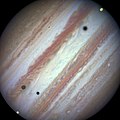Акс:Galilean satellite triple conjunction 2015-01-24 (right).jpg

Акси аслӣ ((1 000 × 1 000 пиксел, ҳаҷми парванда: 584 кбайт, навъи MIME: image/jpeg))
Ин файл аз Викианбор ва дар дигар лоиҳаҳо метавонад истифода шавад. Тафсилоти ин файл саҳифаи тафсилоти файл дар зер нишон дода шудааст.
Хулоса
| ТавсифотGalilean satellite triple conjunction 2015-01-24 (right).jpg |
English: Firing off a string of snapshots like a sports photographer at a NASCAR race, NASA's Hubble Space Telescope captured a rare look at three of Jupiter's largest moons parading across the banded face of the gas-giant planet: Europa, Callisto, and Io.
These so-called Galilean satellites (named after the 17th century scientist Galileo Galilei, who discovered them with a telescope) complete orbits around Jupiter ranging from 2 days to 17 days in duration. They can commonly be seen transiting the face of Jupiter and casting shadows onto its cloud tops. However, seeing three moons transiting the face of Jupiter at the same time is rare, occurring only once or twice a decade. The Hubble image on the left shows the beginning of the event, which took place on January 24, 2015. From left to right the moons Callisto and Io are above Jupiter's cloud tops. The shadows from Europa (not seen in the image), Callisto, and Io are strung out from left to right. Near the end of the event, approximately 42 minutes later (right-side image), Europa has entered the frame at lower left. Slower-moving Callisto is above and to the right of Europa. Fastest-moving Io is approaching the eastern limb of the planet; its shadow is no longer visible on Jupiter. Europa's shadow is toward the left side of the image, and Callisto's shadow to the right. (The moons' orbital velocities are proportionally slower with increasing distance from the planet.) Missing from the sequence is the moon Ganymede, which was outside Hubble's field of view and too far from Jupiter in angular separation to be considered part of the conjunction. The moons in these photos have distinctive colors. The ancient, cratered surface of Callisto is brownish; the smooth icy surface of Europa is yellow-white; and the volcanic, sulfur-dioxide surface of Io is orange. The apparent "fuzziness" of some of the shadows depends on the moons' distances from Jupiter. The farther away a moon is from the planet, the softer the shadow, because the shadow is more spread out across the disk. The images were taken with Hubble's Wide Field Camera 3 in visible light. |
|||
| Сана | (released 5 February 2015) | |||
| Манбаъ | http://hubblesite.org/newscenter/archive/releases/2015/05/image/b/ and http://hubblesite.org/newscenter/archive/releases/2015/05/image/c/ (see also http://heritage.stsci.edu/2015/05/index.html) | |||
| Муаллиф | NASA, ESA, and the Hubble Heritage Team (STScI/AURA) | |||
| Other versions |
|
Иҷозатнома
| Public domainPublic domainfalsefalse |
| This file is in the public domain in the United States because it was solely created by NASA. NASA copyright policy states that "NASA material is not protected by copyright unless noted". (See Template:PD-USGov, NASA copyright policy page or JPL Image Use Policy.) |  | |
 |
Warnings:
|
Таърихи файл
Рӯи таърихҳо клик кунед то нусхаи марбути парвандаро бубинед.
| Таърих | Бандангуштӣ | Андоза | Корбар | Тавзеҳ | |
|---|---|---|---|---|---|
| нусхаи феълӣ | 17:02, 19 феврали 2021 |  | 1 000 × 1 000 (584 кбайт) | Charlestpt | File:Galilean satellite triple conjunction 2015-01-24.jpg cropped 50 % horizontally using CropTool with lossless mode. |
Пайвандҳо
Ин акс дар ҳеҷ саҳифа истифода намешавад.
Истифодаи саросарии парванда
Викиҳои дигари зерин ин файлро истифода мекунанд:
- Истифода дар en.wikipedia.org
- Истифода дар fr.wikipedia.org
Метадода
Ин парванда иттилооти иловагиро дар бар мегирад, эҳтимол аз аксбардораки рақамӣ ё сканер дар вақти сохтан ва рақамӣ кардан, илова шуда. Агар парванда аз вазъияти ибтидоиаш тағйир дода бошад, мумкин аст, шарҳу тафсилоти мавҷуди иттилооти аксро тамоман бозтоб надиҳад.
| Васеъӣ | 1 000 px |
|---|---|
| Баландӣ | 1 000 px |
| Нуқта дар ҳар ҷузъ |
|
| Тарҳи фишурдасозӣ | LZW |
| Таркиби нуқот | RGB |
| Ҷиҳатёбӣ | Оддӣ |
| Теъдоди қисмҳо | 3 |
| Таҳлилпазирии уфуқӣ | 72 dpi |
| Таҳлилпазирии амудӣ | 72 dpi |
| Тартиби додаҳо | Қолаби фарбеҳ |
| Нармафзори истифодашуда | Adobe Photoshop Elements 12.0 Macintosh |
| Таърих ва вақти тағйири парванда | 12:31, 7 феврали 2015 |
| Нусхаи exif | 2.21 |
| Фазои ранг | sRGB |
| Date metadata was last modified | 04:31, 7 феврали 2015 |
| Таърих ва замони рақамӣ(диҷиталӣ) шудан | 04:26, 7 феврали 2015 |
| Unique ID of original document | xmp.did:767D3918392068118083DF440090DADA |
